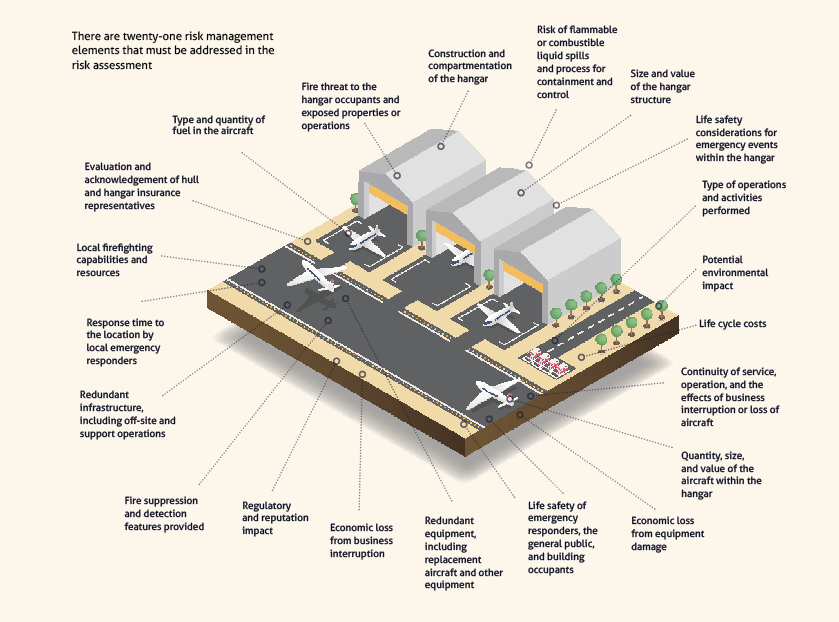23 Dec “New Horizons”
The aviation sector has been seeking change in the fire protection requirements for hangars and the newest edition, 2022, of NFPA 409, Standard on Aircraft Hangars, takes a more holistic approach to a hangar’s fire risk and the protection that should be required. Now Aaron Johnson, Chief Fire Strategist specialising in innovative fire protection solutions for emerging technologies takes up the story.
for the past several years the aviation industry has been pushing for a change in the fire protection requirements for aircraft hangars. This push has been driven by three main factors. These factors include, the high costs of foam discharges without actual fire, negative environmental impacts of foam, and new developments in emerging aircraft technology.
Insurers are having a hard time finding, gathering, and analysing any data that shows a hangar foam fire suppression system being activated by an ignited fuel spill. Rather, what they are discovering is that there is a disproportionate amount of claims involving uncommanded activations; unintentional dispersion of foam; erroneous operation to fire suppression systems; and inadvertent discharge but virtually no claims related to a system discharge in response to fuel spill fire. These lead to an average foam discharge claim of more than $1 million in addition to damages associated with physical damage to the aircraft, lost time and business opportunities, environmental damage and clean-up, and fire suppression system repair
and restoration.
Aqueous film-forming foam (AFFF) has been used for decades as an effective fire extinguishing agent, particularly on class B fires. However, the last few years have proven that these foams contain hazardous per- and polyfluoroalkyl substances (PFAS). This PFAS or PFOA is hazardous to the environment, as well as, to the personnel who may have handled these foams. Now, these foams are being banned through legislation.
As the world turns to alternative energy sources, such as electric and hydrogen, the aviation world is following suit, or perhaps leading the charge. There are more than 200 companies developing aircraft powered by electrical energy sources, hydrogen energy sources, or a hybrid version of these. This move away from traditional liquid carbon-based fuels is driving the need for new and effective fire protection methods.
To address these issues and concerns, the newest edition, 2022, of NFPA 409, Standard on Aircraft Hangars, provides three key changes for aircraft hangar fire protection, a risk-based approach, a performance-based design, and an ignitable liquid drainage floor assembly (ILDFA).
These new fire protection approaches take a more holistic approach to a hangar’s fire risk and the protection that should be required. These approaches consider the threat to the hangar itself and surrounding properties and people, the impact a fire may have on continuity of operations and service or business interruptions, and the environmental impacts of a fire event. Taking these factors into consideration an aircraft hangar can be protected using the prescriptive requirements of the code or one of the alternative fire protection approaches now permitted by the standard.
Twenty-one Questions
A new chapter, Chapter 4, of NFPA 409 outlines now provides for a fire risk-based approach to determine the most appropriate fire protection requirements. This risk-based evaluation will consider “fire risks, hazards associated with the site, services provided, the business continuity planning, and disaster restoration capabilities” unique to each specific hangar.
This risk-based assessment must be conducted and prepared by a licensed professional engineer, and documented and approved by the authority having jurisdiction (AHJ) or fire official. Based on the responses to the twenty-one risk assessment elements a performance-based design may be the best option for the hangar.
The Design Brief
A new chapter, Chapter 5, of NFPA 409 outlines the requirements for implementation of a performance-based design option. The goal of the performance-based design is to allow an “alternative means” of fire protection, while providing an equivalent level of protection, for the aircraft hangar space.
The primary document produced by the performance-based design is the Design Brief. This document is to clearly describe any deviations from the prescriptive requirements of NFPA 409. The design brief must also include the specific inspection, testing, and maintenance (ITM) requirements for the installed fire protection systems and features. Any changes to the ITM frequencies, that deviate from those stated in Chapter 13, are to be outlined in the brief, as well. As with the risk-based approach, the performance-based design must be prepared by a licensed professional engineer with final approval by the AHJ.

Meet ILDFA
The performance-based design approach opens the door for foam fire protection alternatives. One of these alternatives is the newly introduced fire protection system referred to as an ignitable liquid drainage floor assembly (ILDFA).
An ignitable liquid floor drainage assembly is defined by NFPA 409 as, “a drainage system that allows liquids to flow into a listed floor system where liquid is removed from the hangar”. These flooring systems are made up of perforated
planks that allow the liquid to drop through, and then be pushed, via a water source, to a trench drain and holding tank. This flooring system must meet the design specifications of NFPA 409, section 8.12.13, and FM 6090. These requirements include the necessity of the flooring system to “cover all the fuel-containing parts of the aircraft where a fuel spill could occur”, and a drainage rate to accommodate 110% “of the total anticipated fuel discharge rate, plus an allowance for the required sprinkler flow”. Where a hangar utilises an ILDFA system, an NFPA 13, closed-head automatic fire sprinkler system is required to be installed.
As the aviation world continues to evolve, the fire protection requirements must do the same. There is now a path forward, provided for, and outlined in NFPA 409, Standard on Aircraft Hangars. This new guidance for risk-assessments or a performance-based approach provide the latitude for the best and most appropriate fire protection technology and methods to be utilised.






